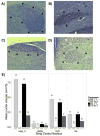Reproductive state modulates testosterone-induced singing in adult female European starlings (Sturnus vulgaris)
- PMID: 25989596
- PMCID: PMC4469036
- DOI: 10.1016/j.yhbeh.2015.04.022
Reproductive state modulates testosterone-induced singing in adult female European starlings (Sturnus vulgaris)
Abstract
European starlings (Sturnus vulgaris) exhibit seasonal changes in singing and in the volumes of the neural substrate. Increases in song nuclei volume are mediated at least in part by increases in day length, which is also associated with increases in plasma testosterone (T), reproductive activity, and singing behavior in males. The correlations between photoperiod (i.e. daylength), T, reproductive state and singing hamper our ability to disentangle causal relationships. We investigated how photoperiodic-induced variation in reproductive state modulates the effects of T on singing behavior and song nuclei volumes in adult female starlings. Female starlings do not naturally produce measureable levels of circulating T but nevertheless respond to exogenous T, which induces male-like singing. We manipulated photoperiod by placing birds in a photosensitive or photorefractory state and then treated them with T-filled or empty silastic implants. We recorded morning singing behavior for 3 weeks, after which we assessed reproductive condition and measured song nuclei volumes. We found that T-treated photosensitive birds sang significantly more than all other groups including T-treated photorefractory birds. All T-treated birds had larger song nuclei volumes than with blank-treated birds (despite photorefractory T-treated birds not increasing song-rate). There was no effect of photoperiod on the song nuclei volumes of T-treated birds. These data show that the behavioral effects of exogenous T can be modulated by reproductive state in adult female songbirds. Furthermore, these data are consistent with other observations that increases in singing rate in response to T are not necessarily due to the direct effects of T on song nuclei volume.
Keywords: Birdsong; Enkephalin; Female songbird; HVC; Neuroplasticity; Photoperiodism; Song; Testosterone.
Copyright © 2015 Elsevier Inc. All rights reserved.
Conflict of interest statement
Figures






Similar articles
-
Photoperiodic condition modulates the effects of testosterone on song control nuclei volumes in male European starlings.Gen Comp Endocrinol. 1997 Feb;105(2):276-83. doi: 10.1006/gcen.1996.6829. Gen Comp Endocrinol. 1997. PMID: 9038260
-
Social context affects testosterone-induced singing and the volume of song control nuclei in male canaries (Serinus canaria).J Neurobiol. 2006 Sep 1;66(10):1044-60. doi: 10.1002/neu.20268. J Neurobiol. 2006. PMID: 16838373
-
Variation in enkephalin immunoreactivity in the social behavior network and song control system of male European starlings (Sturnus vulgaris) is dependent on breeding state and gonadal condition.J Chem Neuroanat. 2012 Mar;43(2):87-95. doi: 10.1016/j.jchemneu.2011.12.001. Epub 2011 Dec 21. J Chem Neuroanat. 2012. PMID: 22198223
-
Photoperiodism, testosterone and adult neurogenesis in canaries (Serinus canaria).J Neuroendocrinol. 2025 Jun;37(6):e13449. doi: 10.1111/jne.13449. Epub 2024 Sep 17. J Neuroendocrinol. 2025. PMID: 39286957 Review.
-
A brain for all seasons: An in vivo MRI perspective on songbirds.J Exp Zool A Ecol Integr Physiol. 2022 Dec;337(9-10):967-984. doi: 10.1002/jez.2650. Epub 2022 Aug 21. J Exp Zool A Ecol Integr Physiol. 2022. PMID: 35989548 Free PMC article. Review.
Cited by
-
Unraveling the Role of Thyroid Hormones in Seasonal Neuroplasticity in European Starlings (Sturnus vulgaris).Front Mol Neurosci. 2022 Jun 28;15:897039. doi: 10.3389/fnmol.2022.897039. eCollection 2022. Front Mol Neurosci. 2022. PMID: 35836548 Free PMC article.
-
The Value of Comparative Animal Research: Krogh's Principle Facilitates Scientific Discoveries.Policy Insights Behav Brain Sci. 2018 Mar;5(1):118-125. doi: 10.1177/2372732217745097. Epub 2017 Dec 21. Policy Insights Behav Brain Sci. 2018. PMID: 32743064 Free PMC article.
-
Uncovering a 'sensitive window' of multisensory and motor neuroplasticity in the cerebrum and cerebellum of male and female starlings.Elife. 2021 Jun 7;10:e66777. doi: 10.7554/eLife.66777. Elife. 2021. PMID: 34096502 Free PMC article.
-
Topography and Lateralized Effect of Acute Aromatase Inhibition on Auditory Processing in a Seasonal Songbird.J Neurosci. 2017 Apr 19;37(16):4243-4254. doi: 10.1523/JNEUROSCI.1961-16.2017. Epub 2017 Mar 17. J Neurosci. 2017. PMID: 28314822 Free PMC article.
References
-
- Arnold AP, Wade J, Grisham W, Jacobs EC, Campagnoni AT. Sexual differentiation of the brain in songbirds. Developmental Neuroscience. 1996;18:124–136. - PubMed
-
- Ball GF, Casto JM, Bernard DJ. Sex differences in the volume of avian song control nuclei: comparative studies and the issue of brain nucleus delineation. Psychoneuroendocrinology. 1994;19(5):485–504. - PubMed
-
- Ball GF, Riters LV, Balthazart J. Neuroendocrinology of song behavior and avian brain plasticity: Multiple sites of action of sex steroid hormones. Frontiers in Neuroendocrinology. 2002;23:137–178. - PubMed
-
- Ball GF, Riters LV, MacDougall-Shackleton SA, Balthazart J. 2008: Sex differences in brain and behavior and the neuroendocrine control of the motivation to sing. In: Ziegler HP, Marler PR, editors. Neuroscience of Birdsong. Cambridge University Press; Cambridge: 2008. pp. 320–331.
Publication types
MeSH terms
Substances
Grants and funding
LinkOut - more resources
Full Text Sources
Other Literature Sources

